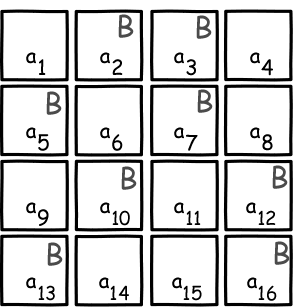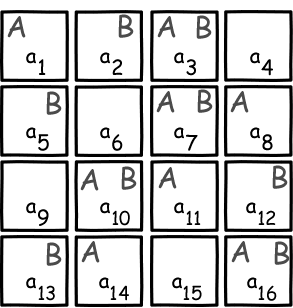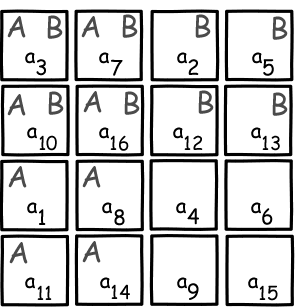A = a1 or a3 or a7 or a8 or a10 or a11 or a14 or a16
B = a2 or a3 or a5 or a7 or a10 or a12 or a13 or a16


| 0 | 1 | 2 | 3 | 4 | 5 | 6 | 7 | 8 | 9 | What Logics of
Induction are There? John D. Norton |
The inductive logics developed here are not defined fully by the deductive structure of their propositions. The no-go result required us to add some purely inductive assumptions. However the deductive component exercises a strong influence on structure of the inductive logics. Here and in the next section, we shall see how some characteristics of the inductive logic are really expressing specific properties of the deductive structure. There are two illustrations. In this section, we will see that inductive independence is generic among large sets of propositions. In the next section, we shall see a limit theorem.
In both cases, the results arise by identifying a distinctive property of the deductive structure and then expressing it in the inductive logic.
Consider a Boolean algebra of propositions with a very large number of atomic propositions. Call the atoms
a1, a2, ... , aN
We form propositions by taking disjunctions of atoms. Some will have only few disjuncts, such as A = a1 or a2; others will have very many disjuncts, such as
B = a1 or a2 or a3 or a4 or a5 or ... or aN-2 or aN-1
If we think of all possible propositions formed this way, what is the most common size, as measured by the number of atoms? This is a familiar problem in combinatorics:
| There is one way to assemble propositions with no atoms: | A = contradiction |
| There are N ways to assemble propositions with one atom: | A=a1, A=a2, A=a3, ... , A=aN. |
| There are N(N-1)/2 ways
to assemble propositions with two atoms: |
A=a1 or a2, A=a1
or a3, ... , A=a1 or aN, A=a2 or a3, ... , A=a2 or aN, ... A=aN-1 or aN. |
| etc. | etc. |
| As the number of atoms in the propositions increases, the number of ways of assembling them grows rapidly. The general formula says that there are N! / n!(N-n)! ways of assembling propositions with n atoms in an algebra of propositions with N atoms. This combinatorial expression has a maximum value at n=N/2 and most propositions tend to cluster around this value when N is large. That tendency grows with N, so that, for N large, virtually all propositions will have around N/2 atoms. This is the first fact about the deductive structure: | How many is "virtually all"? For large N, we can approximate the distribution of propositions by a normal distribution that has a mean at N/2 atoms and a standard deviation of N1/2/2 atoms. This means that the width of the peak at N/2 grows with N1/2, which is more slowly than N. Therefore, for larger N, the peak is increasingly concentrated around the mean N/2. For 99.7% of all propositions, n/N lies in 1/2 +/- 3/(2N1/2), where n is the number of atoms in the proposition. For N=10000, that means that n/N lies in 0.485 to 0.515. |
In a large Boolean algebra of propositions with N atoms, most propositions will have roughly N/2 atoms.
Similar considerations apply when we consider pairs of propositions. We find that there are many ways of forming pairs of propositions. For large N, the overwhelmingly most common ways have roughly N/2 atoms in each. If we pick one atom in the first, it is just as common for it to be in the other proposition as for it not to be in the other proposition. That means:
In a large Boolean algebra of propositions with N atoms, most pairs of propositions will agree in roughly N/4 of their N/2 atoms; and disagree in roughly N/4 of their N/2 atoms.
We can illustrate this last fact by considering the case of an algebra with
N=16 atoms. Although this is a relatively small
number in terms of the results to be developed here, the smallness makes
drawing a figure easier.
| A typical proposition in this algebra will have
roughly 8 atoms. It might be: A = a1 or a3 or a7 or a8 or a10 or a11 or a14 or a16 |
Another typical proposition in this algebra will
have roughly 8 atoms. It might be: B = a2 or a3 or a5 or a7 or a10 or a12 or a13 or a16 |
 |
 |
The figures above display the 16 atoms of the Boolean algebra and indicate which appear in proposition A by the label "A"; and which in proposition B by the label "B."
Both assignments are displayed in one figure opposite.You can see how the atoms of A and the atoms of B are scattered haphazardly over the 16 possible atoms. The randomness of the scattering assures us that as many of the atoms of A will also be in B as are not in B. |
 |
 |
This last fact about the atoms of A and B is
easier to see if we rearrange the 8 atoms of A to lie in the first
two columns of the figure; and if we rearrange the atoms of B to lie
in the first two rows. Then we see instantly that:
(fraction of N atoms in A&B =1/4)
= (fraction of N atoms in A = 1/2) x (fraction of N atoms in B = 1/2) |
These are the two facts that we seek to express in the deductively definable logics of induction.
What does is mean to say that two propositions are inductively independent of one another? It simply means that learning one has no inductive value to the other. That is to say that A is inductively independent of B if learning the truth of B or the falsity of B lends equal support to A. That is
(inductive independence) [A|B] = [A|~B]
We apply this definition to the most common pairs of propositions, A and B. The numbers of atoms associated with them are:
#A = N/2 #B = N/2#A&B = N/4#A&~B = N/4 #~A&B = N/4#~A&~B = N/4
Inserting these values into the expression (S) that obtains in inductively adapted partitions, we find:
| [A|B] = fN(#A&B, #A&~B, #~A&B) = fN(N/4, N/4, N/4) |
[A|~B] = fN(#A&~B, #A&B, #~A&~B) = fN(N/4, N/4, N/4) |
Hence[A|B] = [A|~B] and A and B are inductively independent.
| This last calculation shows that inductive
independence obtains for the most commonly occurring pairs of
propositions. It does not show that inductive independence obtains
for most propositions. Extending the analysis from "most common" to "most" requires some
detailed and fussy analysis that need not detain us here. We need to
resort to algebras with very large N and use the fact that then most
pairs of propositions will have nearly, but not exactly, N/2 atoms
and agree on nearly, but not exactly, N/4 atoms. That means that the
equality [A|B] = [A|~B] will only hold approximately. Making sense of
the "approximately" will in turn require a notion of continuity of
strengths. |
Most common? Most? What's the difference? The most common propositions have exactly N/2 atoms, but they are only a small fraction of all propositions. Most propositions--meaning, say, 99.7% of them--will have roughly, but not exactly, N/2 atoms. |
| 0 | 1 | 2 | 3 | 4 | 5 | 6 | 7 | 8 | 9 | What Logics of
Induction are There? John D. Norton |